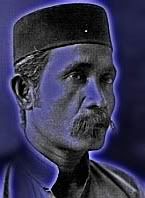2. How to...Kuör
Golfers, like Glen Miller, know the swing, but they do not know the art of kuör. In 1836 when Abdullah Munshi took a peek at Kuala Trengganu, alarm bells rang in his head when he saw knife and spear brandishing men walking up and down the Kampung Laut thoroughfare, which was near the latter Jalan Pantai. It scared the s**t out of him and filled he was with much trembling when he hastened back to report to Tuan Raffles. This was nothing to us, and no one — as far as we know — got hurt from it, for this was just the art of kuör . As evidence shows, you could, if you would, kuör with almost anything: a long stick, a smudged spatula, a piece of driftwood or a bit of broken broom handle. But for best effect, it is better to kuör with something menacing, like a long kris or a spear adorned with a knotted bandana.
There is evidence to show that the kuör went beyond 1836 and was there to fascinate Admiral Cheng Ho when he came with the monsoon winds to Trengganu and sailed steadily upriver. Kuör is waving with menace with an element that is almost lakadaisical. But that is downgrading kuör to a leisurely art, for kuör is that and a little bit more. It is difficult to judge the intention of a kuörer, whether he means hurt or is merely swatting a fly, but woe betide the person who thinks that the kuör is incapable of serious thought for kuör can be a pleasure per se (which is kuör properly so called) or a prelude to some serious damage to dentistry (the opponent’s normally) or the areas lying below the navel.
The essence of kuör is in the beholder much as brandishing is useless if done in camera. But there’s a difference between a person who’s doing the kuör and a man who’s merely brandishing a stick, say, for in the latter the stick is a mere protrusion but in the kuör is transference of kinetic energy from the doer’s mind to the paraphernalia, moving and swishing ever so slightly, or in full motion as it were.
It’s bad form to kuör in front of elders, and/or especially your mother-in-law, even if it’s just your roti kaya, waved to climax an exciting story. Kuör if you can, to keep your opponents safely at bay, but the opposite of kuör is lik, which is a form of evasive action, and he who successfully liks a kuör will live to fight another day.

